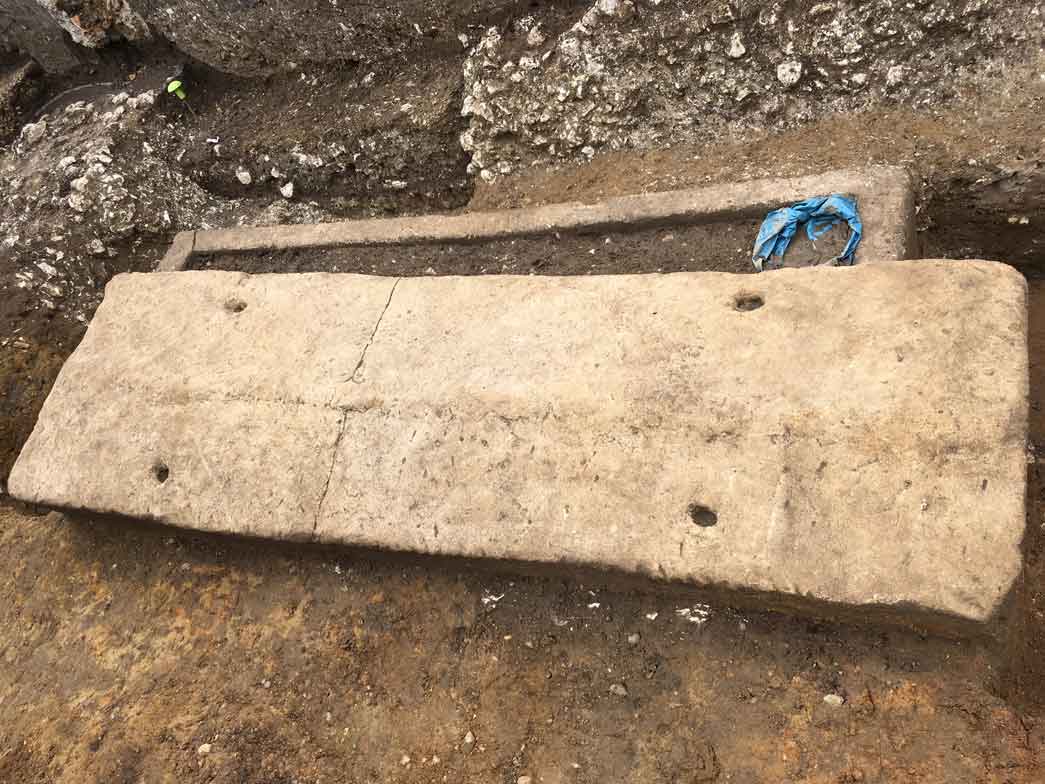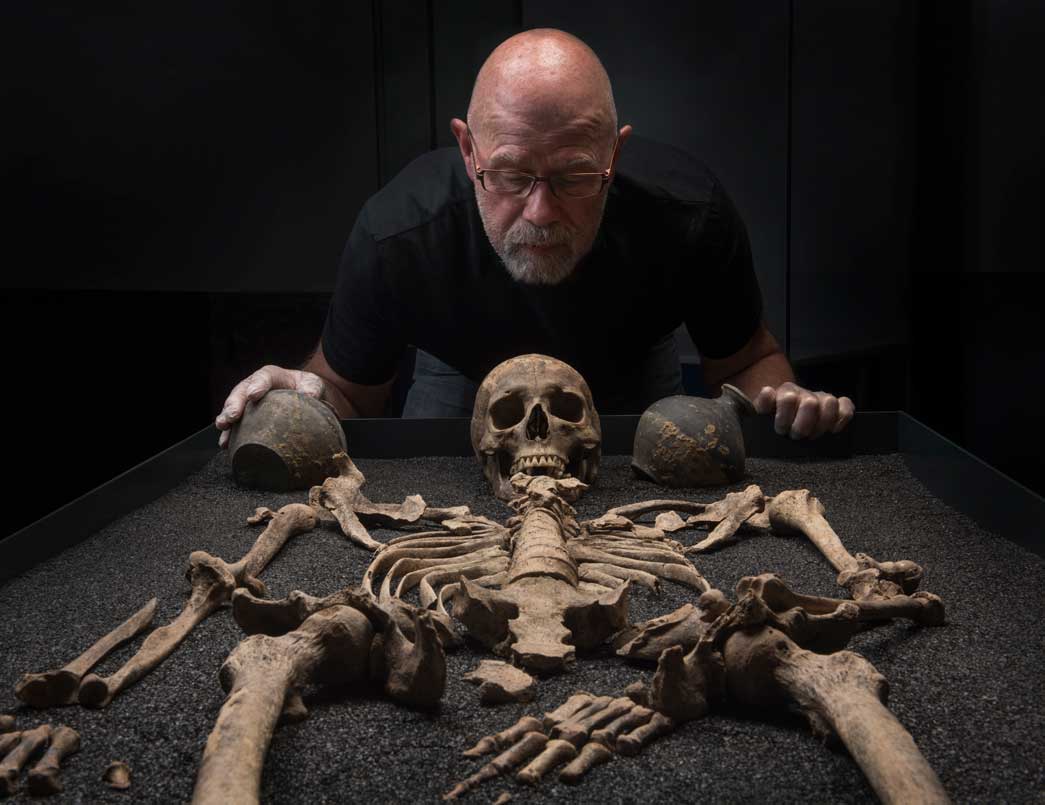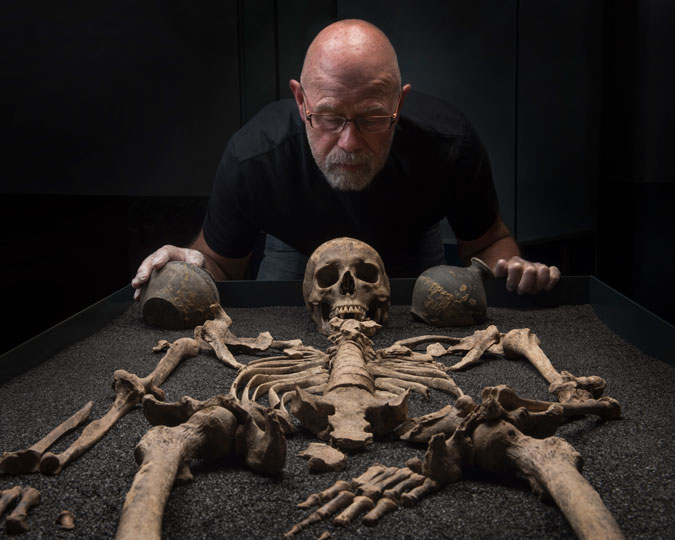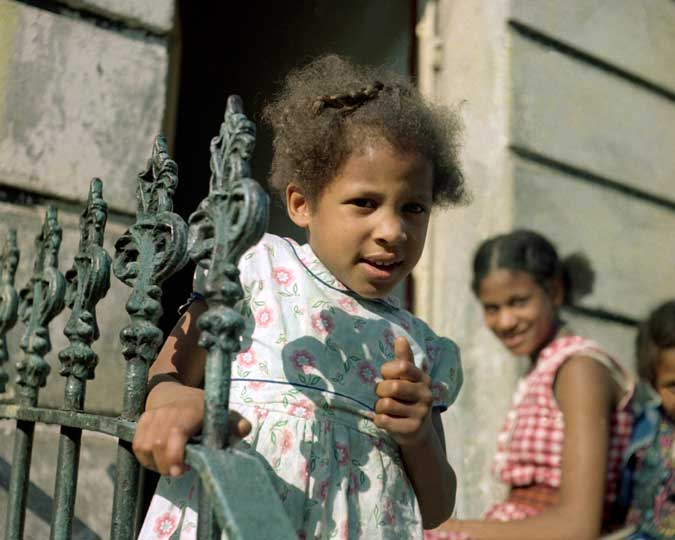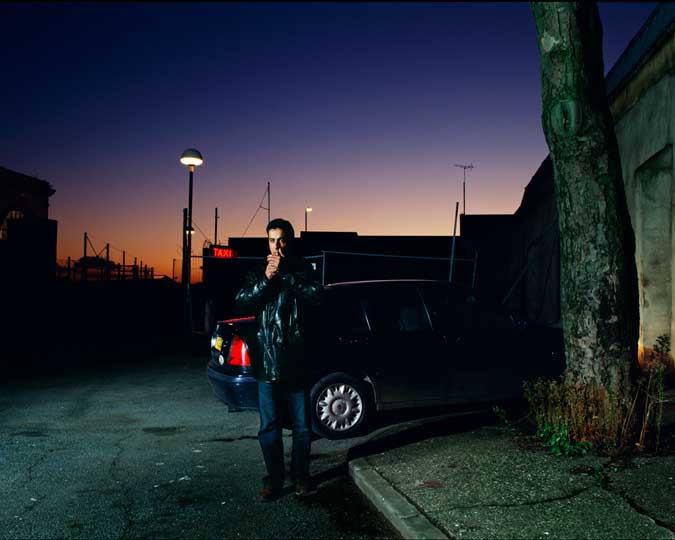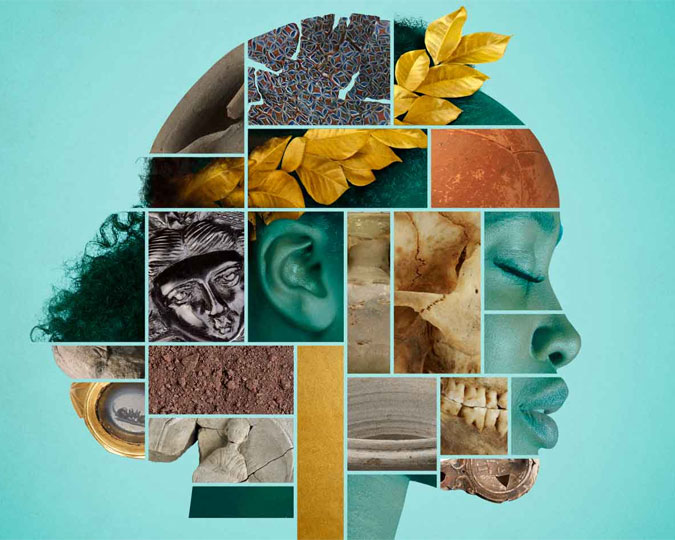Our Roman Dead exhibition at the Museum of London Docklands showcased the diverse community of Roman Londinium. Dr. Rebecca Redfern writes about new research revealing how our vision of Roman Londoners needs to change.
The Roman Empire covered most of western Europe and the Mediterranean, bringing together geographically and genetically diverse communities through trade and military conquest. People travelled vast distances for different reasons: some because of their occupation, like soldiers or merchants; some had no choice, such as enslaved people. These journeys were recorded in the form of inscriptions on tombstones or memorials, and in material culture, such as dress accessories. Roman citizens often settled and died far from their birth-place.
In Britain, where Roman inscriptions are less common compared to other countries, the remains of past people are an independent source of evidence for these journeys and migrations. By studying their skeletons and the chemicals in their teeth and bones, we are able to shed light on where Roman Londoners spent their early childhood, their ancestry, how they lived and what they ate.
Under Londinium: what the graves can tell us
![A marble inscription that reads: 'NVM[INIBVS] AVG[VSTORUM]/ DEO MARTI CA/MULO TIBERINI/VS CELERANVS/ C[VIS] BELL[OVACVS]/MORITIX/LONDINIENSI/VM/PRIMVS...VA...', meaning 'To the Divinities of the Emperors (and) to the god Mars Camulos. Tiberinius Celerianus, a citizen of the Bellovaci, moritix, of Londoners the first...'.](/application/files/9515/3062/6093/Roman-grave-inscription.jpg)
A marble inscription that reads: 'To the Divinities of the Emperors (and) to the god Mars Camulos. Tiberinius Celerianus, a citizen of the Bellovaci, moritix, of Londoners the first...'.
The Roman settlement of Londinium was established in about 48 AD by groups of merchants and traders, with the support of the military. By 60 AD, it was described by the Romanauthor Tacitus (Annals 14.33) as a centre of commerce, evidenced by material culture from the near Continent and the south and east Mediterranean region.
After the Boudican rebellion (60 AD), it was rebuilt and extended to include a forum, military fort, amphitheatre and the governor’s palace. The cemeteries established in the 1st century AD, lined the main roads out of the settlement, containing the inhumations (burials of bodies) and cremations (remains of burned bodies). The majority of individuals were buried without grave-goods, but several high status and rare burials in lead coffins and sarcophagi have been encountered – including the newly excavated sarcophagus from Southwark, the inspiration for ‘Roman Dead’.
Inscription evidence from tombstones reveals that Londinium’s inhabitants included serving and retired military personnel (also on display), a merchant from Antioch and another man born in Athens, Greece. There is also a dedication by a French citizen - which uses the Celtic word ‘moritix’ meaning seafarer – he may have been part of a group of commercial travellers from Gaul.
Care must be taken when interpreting inscriptions, as in the case of the funerary inscription for Tullia Numidia. Her name suggests a link to the region of Numidia, which is now part of modern Algeria and Tunisia, but it does not mean that she came from that area of the Empire.
What the bones tell us: Archaeological techniques
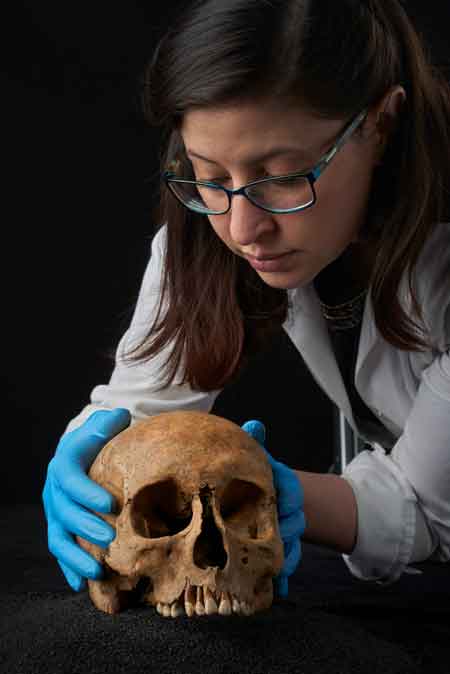
Museum of London conservator Luisa Duarte holds a 17 year old boy buried in Lant Street
Macromorphoscopics gives us information about the ancestry of the dead from studying different bones in the skull.
In order to investigate population diversity in the past, bioarchaeologists use several techniques: forensic ancestry methods, light stable isotopes and ancient DNA.
Forensic ancestry methods are based on data collected from individuals who have died within the past one hundred years, which we compare to ancient human remains. The method we chose is called Macromorphoscopics, which studies the shape of different bones of the cranium, reflecting soft-tissue differences in the living. However, modern genomic studies have shown there are differences between a person’s genomes, skin colour and ethnic/population identity, showing that we need to use as many techniques as possible to achieve a nuanced understanding of a person's ancestry.
Light stable isotope analyses are used by archaeologists to study people’s diet and their place of childhood origin. We analyse particular chemicals which become incorporated into people’s skeletons and teeth through the foods they eat and the water they drink. Carbon and nitrogen isotopes can give us clues about their diet, and we know about where they grew up from analysing oxygen, strontium, lead in their bones and dental enamel.
Ancient DNA analysis is able to provide evidence about haplotypes in people's genes, which differ between populations across the world. At the Museum of London, we have focused on population haplogroups, which are found in a person’s mitochondrial DNA, only passed on from mother-to-child and containing information about a person's heredity . Archaeological studies have shown that place of childhood origin does not always correspond with a person’s ancient DNA, and this is why it is important to study both.
Diversity in Londinium: the many faces of Roman London
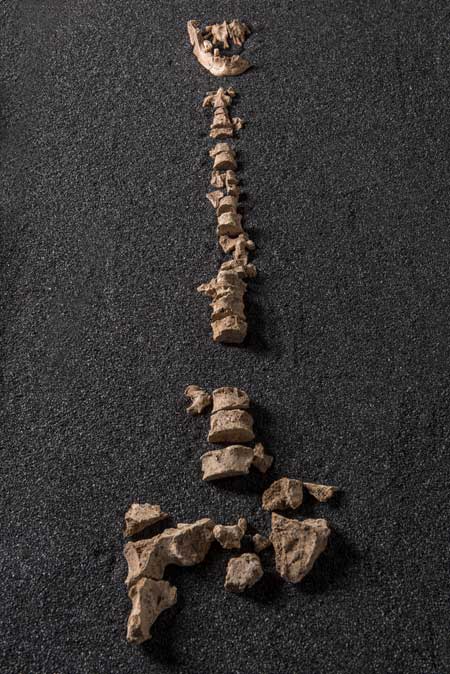
The truncated skeleton of a man with Black African ancestry
This individual was unearthed in a Roman burial site in London
Although some funerary inscriptions have been discovered, none have been found in situ, so the only source of evidence for people travelling are the chemicals in their skeleton. We have studied the remains of over 50 children and adults who lived in Londinium throughout the Roman period, and discovered many fascinating stories.
As expected, we found several individuals who spent their early childhood in London, including two males over 46 years old, one of whom has Black African ancestry and the other (on display in Roman Dead), who has White European ancestry and was buried with large crossbow brooch, which would have been use to fasten outer garments at the shoulder.
These brooches are often found in the burials of men, women and children in military zones, and are believed to indicate a high social status. He was also accompanied by a chip-carved belt-buckle, another distinctive object and one associated with the military and Imperial administration.
The burial of the male with Black African ancestry had been damaged by 19th and 20th century construction work. His skeleton had been disturbed and what archaeologists call ‘truncated’, meaning that only part of his skull, spine and pelvis remained. No grave-goods were found. We were fortunate enough to be able to investigate his mitochondrial DNA and some aspects of his identity, which revealed that he had brown eyes and dark brown/brown hair, and his maternal haplotype is found in populations across Europe and North Africa, but the stable isotope evidence showed that he had grown up in London.
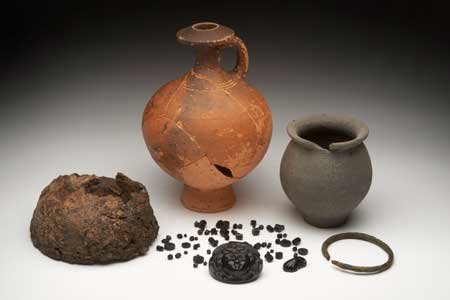
Grave goods buried alongside Roman Londoners
On display in Roman Dead
Also present are individuals who travelled to Londinium from the Continent, including an adult female with White European ancestry who was buried with two large tutulus brooches, a triangular composite antler comb and a pottery flagon. Like the older man, these objects have Continental connections, and her stable isotope results suggest that she may have come to London from Germany.
Not all migrants were adults: we excavated an eight year old child buried in coffin whose base was covered in a chalk-like substance. Studies suggest that this means that the deceased body had been embalmed. The child's body was accompanied by 3 copper-alloy bracelets, which had been placed by their right ankle, and a fragment of a fine wire chain. Unlike the belt, brooches and comb, these objects suggest a British origin, but their stable isotopes show that they had spent most of their life on the Continent.
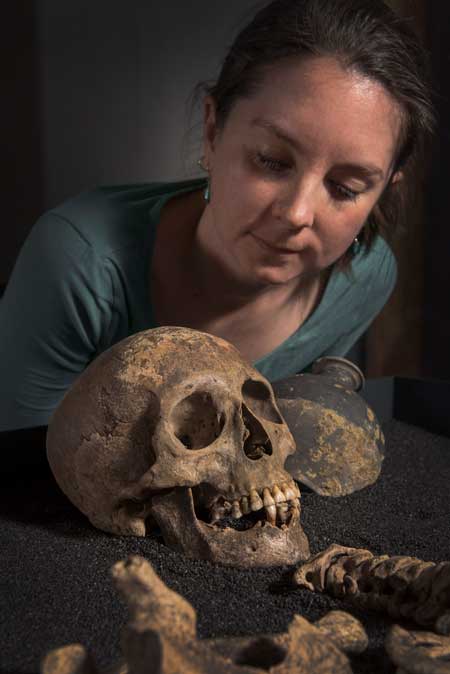
Curator Meriel Jeater with a Roman skull
This 36-45 year old woman had Black African ancestry, and inspired the poster for the exhibition (at the top of this article).
In our study of a cemetery from Southwark, we were able to study ancestry, childhood origin and for some individuals, their diet. We discovered that over the centuries in which the cemetery was in use, some of the interred were adult individuals with Black African ancestry, all of whom appear to have travelled from the southern Mediterranean. None of these individuals were buried with objects suggesting connections outside of Britain.
For example, the 36-45 year old woman who is the inspiration for the exhibition poster was buried with pottery made in southeast England.
Diet can be used to investigate mobility, as different food sources and origins give different chemical signatures. The analysis of the rib bone from one fourteen-year-old migrant from the southern Mediterranean showed that they had been living in London for at least five years, because the food signatures were local to London, and we know that rib bone remodels every five years.
Our work shows that Londinium was a vibrant and diverse settlement, and from its inception, was home to people from across the Roman Empire. Their funerals and their choice of grave-goods reflect the coming-together of these different communities, and when combined with bioarchaeology, show that ancestry and region of birth are not always the same. The inhabitants of Londinium created new identities, mixing their place of origin, occupation and native customs together into something distinctly London.
Thanks and acknowledgements
Durham University: Drs Becky Gowland, Andrew Millard, Janet Montgomery, Darren Gröcke, Lindsay Powell, and Lucie Johnson
McMaster University: Prof. Hendrik Poinar and Dr Katherine Eaton.
Pre-Construct Archaeology: Victoria Ridgeway
Museum of London Archaeology: Michael Marshall
References
Banda, Y., Kvale, M. N., Hoffmann, T. J., Hesselson, S. E., Ranatunga, D., Tang, H., Sabatti, C., Croen, L.A., Dispensa, B.P., Henderson, M., Iribarren, C., Jorgenson, E., Kushi, .H., Ludwig, D., Olberg, D., Quesenberry, C.P., Rowell, S., Sadler M., Sakoda, L.C., Sciortino, S., Shen, L., Smethurst, D., Somkin C.P., Van Den Eeden, S., Walter, L., Whitmer, R.A., Kwok, P-Y., Schaefer, C., and Risch, N. (2015). Characterizing Race/Ethnicity and Genetic Ancestry for 100,000 Subjects in the Genetic Epidemiology Research on Adult Health and Aging (GERA) Cohort. Genetics, 200(4), 1285-1295. doi:10.1534/genetics.115.178616
Hefner, J.T., 2011. Chapter 9: macromorphoscopics. In: Wilczak, C., Dudar, J.C. (Eds.), Osteoware Software Manual, Volume 1. Developed by the Repatriation Osteology Lab, Smithsonian Institution. Smithsonian Institution: Washington D.C., pp. 66-78.
Hefner, J.T., 2016. Biological distance analysis, cranial morphoscopic traits, and ancestry assessments in forensic anthropology. In: Pilloud, M.A., Hefner, J.T. (Eds.), Biological Distance Analysis: Forensic and Bioarchaeological Perspectives. Academic Press: Cambridge, pp. 297-310.
Roman Dead closed on 29 October 2018.








